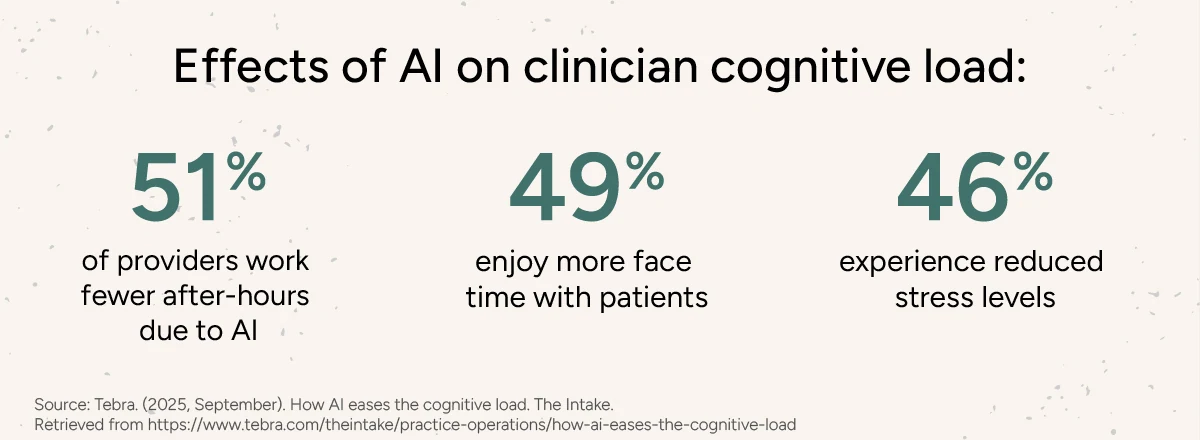The story of healthcare AI is a classic coming-of-age tale, except our protagonist is not a precocious student; it is a collection of algorithms learning how to survive (and thrive) in the clinical world. Once the supporting cast, classical AI systems focused on symbolic AI and rules-based automation. Today, the spotlight shines on agentic AI, call them the self-starters of the silicon world. Unlike their rule-following ancestors, agentic AI systems autonomously manage complex tasks, streamline workflows, and even lower cognitive workload for clinicians. A Tebra survey1 found that 51% of providers reported working fewer after-hours due to AI, 49% enjoy more face time with patients, and 46% experience reduced stress levels.

Across the country, primary-care teams struggle to manage growing panels of patients with complex needs. A single office visit often generates a cascade of follow-ups; new prescriptions, lab monitoring, lifestyle counseling, referrals, and patient questions, that can overwhelm both staff and patients. Despite good intentions, preventive services are missed, adherence falls off, and clinicians burn out under the administrative load.
Agentic AI offers a path to relieve this pressure. Rather than simply alerting clinicians to an elevated blood pressure, a well-designed agent could coordinate the follow-up: confirm the prescription was filled, schedule the lab draw, send tailored self-management tips to the patient, and flag only those cases that truly need clinician review. At the same time, the agent could screen for affordability or access barriers and route those to the appropriate support resource—freeing the care team to focus on clinical decision-making. Early evidence: AI-based monitoring systems routinely catch complications earlier, leading to fewer hospitalizations and better outcomes. Imagine a nurse who not only remembers every patient’s chart but also adjusts her own schedule when things get hairy in the ER. Agentic AI doesn’t just execute commands, it optimizes, improvises, and self-corrects as new patient data flows in.
Of course, with great autonomy comes great responsibility. Healthcare’s agentic AI is more than just clever code, it’s the skeleton key to personalized, efficient, and resilient delivery.
The Shift: From Tools to Teammates
In healthcare, this isn’t just a fancy upgrade; it’s a paradigm shift. Think about a primary care setting, often a whirlwind of appointments, administrative tasks, and complex patient needs. An assistive AI might highlight a patient’s elevated blood pressure. An agentic AI, however, could not only flag that but also proactively schedule a follow-up, suggest lifestyle modifications based on the patient’s record, coordinate with a nutritionist, and even pre-populate relevant sections of the EHR, all while learning from its interactions to refine its future actions.
The implications for healthcare delivery are profound. We’re moving beyond AI that helps us do our jobs better, to AI that can share the workload and even anticipate needs, augmenting clinical capabilities to an unprecedented degree. Over 79%2 of healthcare organizations already use some form of AI, and the market is on fire: from $26.5 billion in 2024 to an expected $187.7 billion by 2030, growing at a blistering 38% CAGR3. ROI is real, too, $3.20 for every $1 invested, often realized within 14 months. A significant portion of these will come from automating administrative tasks and optimizing clinical workflows, areas ripe for agentic AI.
Why Now? The Perfect Storm
This evolution isn’t happening in a vacuum. Several factors are accelerating the move towards agentic AI in healthcare:
- Massive Data Availability: EHRs, wearables, genomic data – we’re awash in information that agentic AI can process and learn from.
- Advances in Machine Learning: Sophisticated algorithms, especially in reinforcement learning and natural language processing, are enabling more complex decision-making.
- Computational Power: Cloud computing and specialized hardware make it feasible to run these intricate systems.
- The Quadruple Aim: The relentless pressure to improve patient experience, improve population health, reduce costs, and improve the work life of healthcare providers is driving the need for more efficient and effective solutions.
Consider the complexity of managing chronic conditions. An agentic AI could continuously monitor a diabetic patient’s glucose levels via connected devices, recommend medication adjustments, provide personalized dietary advice, and alert the care team only when significant intervention is needed. This moves us from reactive care to truly proactive and personalized health management.
The journey from assistive to autonomous AI in healthcare is not just about technological advancement; it’s about reimagining how care is delivered. It’s about empowering clinicians, engaging patients, and ultimately, building a more resilient and responsive healthcare system. The future of primary care isn’t just digitally enabled; it’s intelligently autonomous, ready to act and adapt.
Schedule a Tom Demo
References
- Tebra. (2025, September). How AI eases the cognitive load. The Intake. Retrieved from https://www.tebra.com/theintake/practice-operations/how-ai-eases-the-cognitive-load
- Smith, A. (2024, October). AI in healthcare: How it’s used and what the future holds. HealthTech Magazine. Retrieved from https://healthtechmagazine.net/article/2024/10/ai-in-healthcare-how-its-used-future-perfcon
- Grand View Research. (2024). Artificial intelligence in healthcare market size, share & trends analysis report by component, by application, by end use, by region, and segment forecasts, 2024–2030. Retrieved from https://www.grandviewresearch.com/industry-analysis/artificial-intelligence-ai-healthcare-market